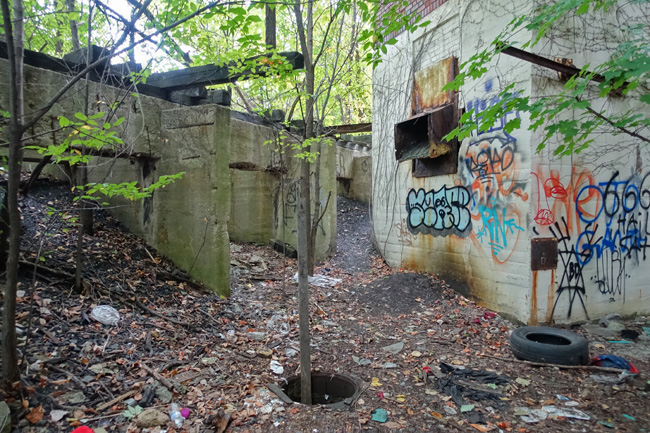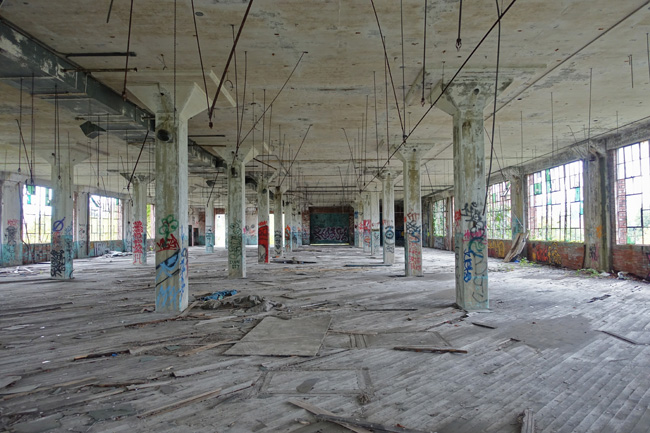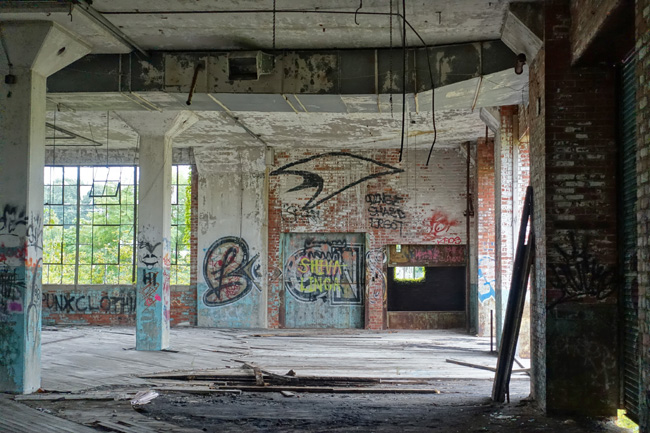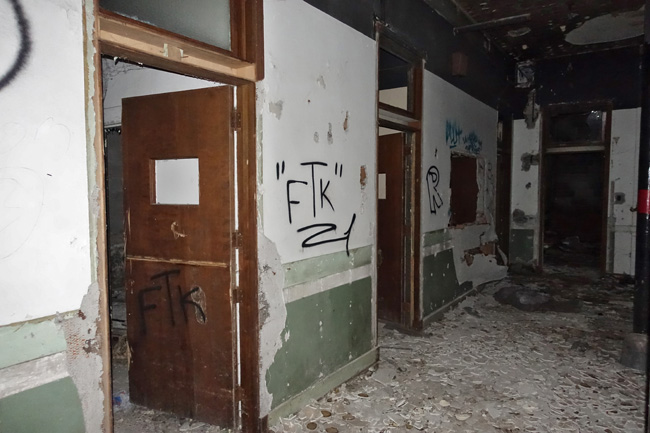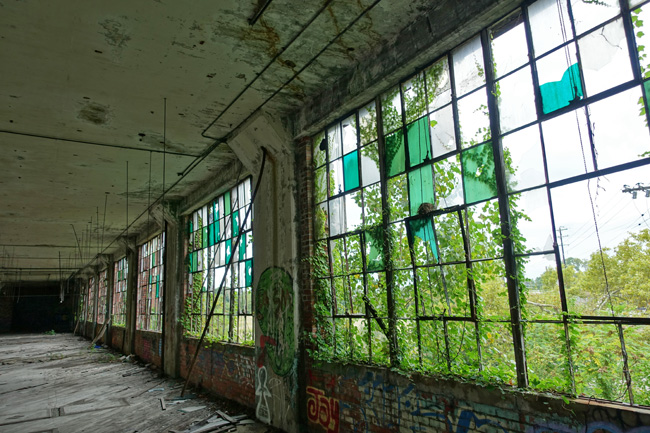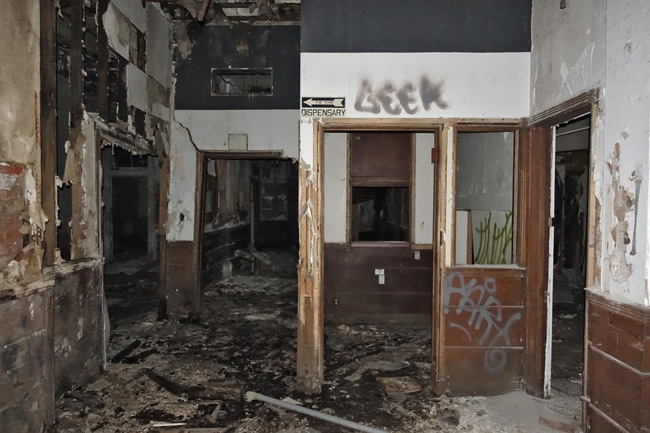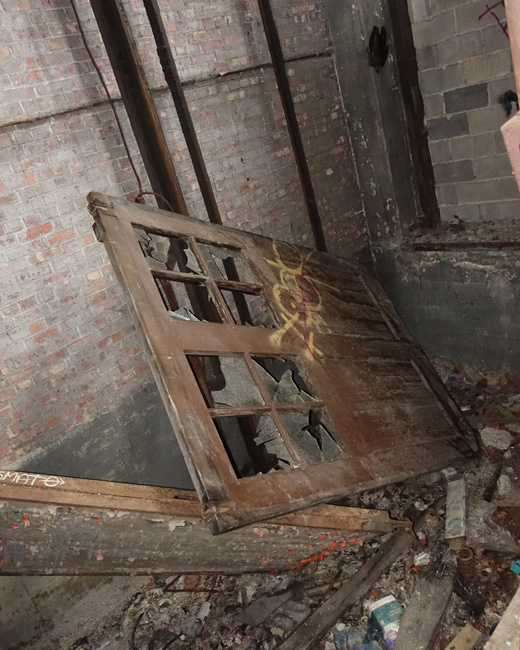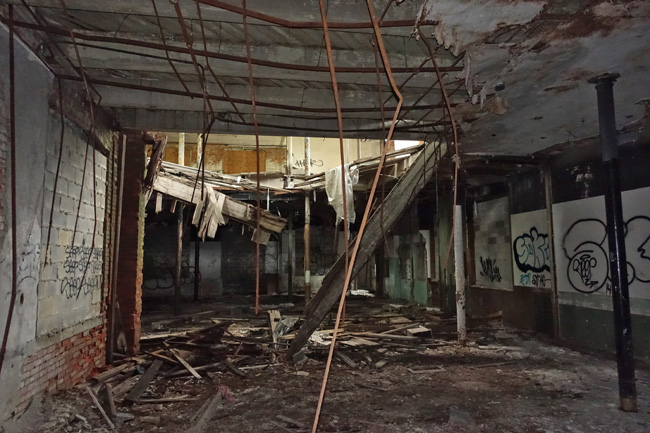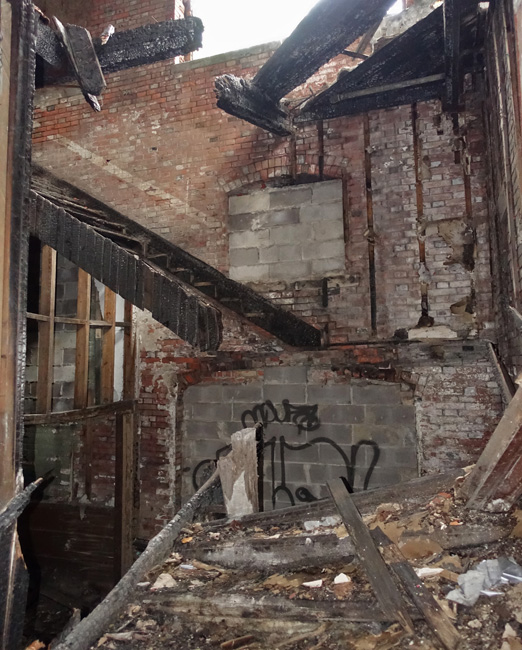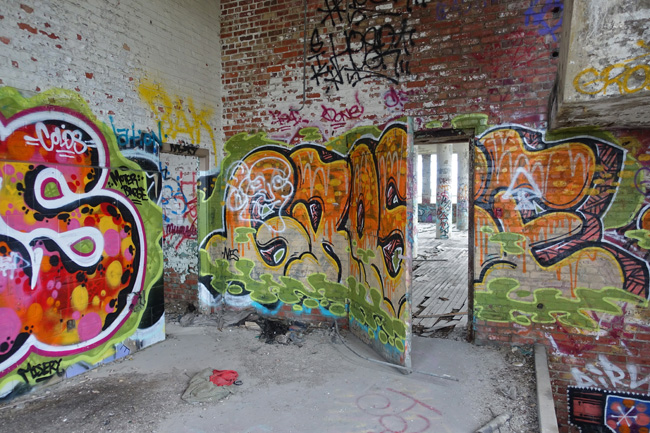After I stopped to visit an abandoned headboard factory and the car audio shop that bordered it, my time in Cleveland was nearly at an end. But before I could leave the city, I had to check out the magnificent remains of the Joseph & Feiss Clothcraft industrial compound.
The grounds, which lie along West 53rd Street just south of the I-90, were overgrown with tall grass, brush and small trees. The massive manufacturing plant that occupied the majority of the property was demolished in 2003-2004, leaving only the administrative building and the three-story warehouse structure.
A black banner with white lettering reading Menlo Park Academy flapped in the wind. I had read that there was an effort to convert the old structure into a school, but the bleak state of the place made me doubt it would ever come to fruition. Ameri Con Corporation had purchased the land in 2000 with the intention of developing condos, but those plans had been abandoned. I assumed the dream of Menlo Park Academy would meet a similar fate.
The Joseph and Feiss Company began as a store in Meadville, PA. Founded in 1841, it was originally known as Koch and Loeb. The business moved to Cleveland in 1845, where it sold clothing for men and boys and piece goods to local tailors.
In the early years, the clothing was made by small local shops. Then, in 1897, the company switched to manufacturing everything internally. The local shops were folded into one centralized manufacturing facility and the former owners were hired as operators and foremen.
In 1907, senior partners Moritz Joseph and Julius Feiss changed the company name to Joseph & Feiss Co, though the clothing was sold under the brand name Clothcraft. Their $15 blue serge suit was extremely popular and was marketed as the Model T of the clothing industry.
Julius Feiss's son Richard Feiss became factory manager in 1909. Richard strove to increase productivity through use of scientific management principles and reshaped company policies to improve the quality of life of his employees. Under his leadership the company developed a reputation as having the most progressive work environment in the country. He hired Mary Barnett Gilson, a Progressive Era reformer, as head of the employment and services department. With employee health in mind, they redesigned worktables and chairs and ensured proper lighting and ventilation in work areas. Feiss introduced benefits such as medical and counseling services and employee savings programs, allowed workers an opportunity to participate in decision making, and rewarded them with performance-based promotions and wage increases.
Under the leadership of Richard Feiss the company also held dances, picnics, music and athletic programs, clubs, and a choir. In 1917, he instituted a five-day work week for employees, years before Henry Ford did, though Ford is often credited as the first US industrial employer to do so. It is believed that the generous benefits enjoyed by Joseph & Feiss employees prevented them from unionizing during a period when unions were becoming increasingly popular.
Due to the growth of the business, Joseph & Feiss relocated to its new W. 53rd street factory in 1920 and officially became incorporated in the same year.
During World War II, Joseph & Feiss was a major producer of uniforms for the US Army and Navy. In the ensuing decades, the company acquired other brands and diversified its clothing lines, eventually adding tailored clothes for women. Joseph & Feiss merged with Phillips-Van Heusen in 1966, and then was acquired by Hugo Boss in 1980.
As casual clothing became more mainstream, business suffered and mass layoffs occurred. In 1997 the massive plant on West 53rd Street closed and operations moved to the company's distribution center in the Brooklyn area of Cleveland, where it still operates today.
The West 53rd Street plant stood abandoned for nearly two decades, a sad reminder for ex-employees who watched their former workplace fall into increasing disrepair.
There is some beauty to be found in it though. When nature creeps back into a site long occupied by human industry the results can be striking.
Even some of the graffiti isn't all that bad to look at.
After nearly twenty years of disrepair and decay, the old Joseph & Feiss factory has found new purpose. In 2015, Menlo Park Academy, a school for gifted children, bought the property with the intention of expanding their school. In 2016 Menlo Park Academy received a $4.6 million grant from the state to renovate the historic building and transform it into a tuition-free educational center for gifted youth. The new school opened in 2017.
After a memorable few days exploring some of Cleveland's most fascinating historic buildings, I hit the road and headed to Toledo, home of the abandoned Riverside Hospital.
Thank you for checking out this article. If you enjoyed it, please share it on Facebook.
To receive an email announcement when I post my next article, please subscribe to Places That Were.
Until then, click here to read about other abandoned places I've explored.
To see more pictures, please follow these links and subscribe to my feeds:
Facebook: http://www.facebook.com/placesthatwere
Instagram: http://instagram.com/theplacesthatwere
Twitter: https://twitter.com/placesthatwere/
Tumblr: http://placesthatwere.tumblr.com/
Google+: https://plus.google.com/u/0/+JimSullivanPlacesThatWere/posts
EyeEm: https://www.eyeem.com/u/placesthatwere
Youtube: https://www.youtube.com/jimplicit
Thank you!




